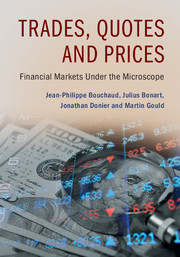Book contents
- Frontmatter
- Dedication
- Contents
- Preface
- Acknowledgements
- PART I HOW AND WHY DO PRICES MOVE?
- PART II LIMIT ORDER BOOKS: INTRODUCTION
- PART III LIMIT ORDER BOOKS: MODELS
- PART IV CLUSTERING AND CORRELATIONS
- PART V PRICE IMPACT
- PART VI MARKET DYNAMICS AT THE MICRO-SCALE
- PART VII ADVERSE SELECTION AND LIQUIDITY PROVISION
- PART VIII MARKET DYNAMICS AT THE MESO-SCALE
- PART IX PRACTICAL CONSEQUENCES
- 21 Optimal Execution
- 22 Market Fairness and Stability
- Appendix
- Index
- References
22 - Market Fairness and Stability
from PART IX - PRACTICAL CONSEQUENCES
Published online by Cambridge University Press: 26 February 2018
- Frontmatter
- Dedication
- Contents
- Preface
- Acknowledgements
- PART I HOW AND WHY DO PRICES MOVE?
- PART II LIMIT ORDER BOOKS: INTRODUCTION
- PART III LIMIT ORDER BOOKS: MODELS
- PART IV CLUSTERING AND CORRELATIONS
- PART V PRICE IMPACT
- PART VI MARKET DYNAMICS AT THE MICRO-SCALE
- PART VII ADVERSE SELECTION AND LIQUIDITY PROVISION
- PART VIII MARKET DYNAMICS AT THE MESO-SCALE
- PART IX PRACTICAL CONSEQUENCES
- 21 Optimal Execution
- 22 Market Fairness and Stability
- Appendix
- Index
- References
Summary
When men are in close touch with each other, they no longer decide randomly and independently of each other, they each react to the others. Multiple causes come into play which trouble them and pull them from side to side, but there is one thing that these influences cannot destroy and that is their tendency to behave like Panurges sheep.
(Henri Poincaré, Comments on Bachelier's thesis)As is stated in any book on market microstructure (including the present one!), markets must be organised such that trading is fair and orderly. This means that markets should make the best efforts to be an even playing field for all market participants, and should operate such that prices are as stable as possible. As we emphasised in Chapter 1, market stability relies heavily on the existence of liquidity providers, who efficiently buffer instantaneous fluctuations in supply and demand, and smooth out the trading process. It seems reasonable that these liquidity providers should receive some reward for stabilising markets, since by doing so they expose themselves to the risk of extreme adverse price moves. However, rewarding these liquidity providers too heavily is in direct conflict with the requirement that markets are fair. In summary, if bid–ask spreads are too small, then liquidity providers are not sufficiently incentivised, so liquidity becomes fragile; if bid–ask spreads are too wide, then the costs of trading become unacceptable for other investors.
The rise of electronic-markets with competing venues and platforms is an elegant way to solve this dual problem, through the usual argument of competition. In a situation where all market participants can act either as liquidity providers or as liquidity takers (depending on their preferences and on market conditions), the burden of providing liquidity is shared, and bid–ask spreads should settle around fair values, as dictated by the market. As we saw in Chapter 17, this indeed seems to be the case in most modern liquid markets, such as major stock markets, futures and FX markets, in which the average bid–ask spread and the costs associated with adverse selection offset each other almost exactly.
- Type
- Chapter
- Information
- Trades, Quotes and PricesFinancial Markets Under the Microscope, pp. 406 - 421Publisher: Cambridge University PressPrint publication year: 2018

